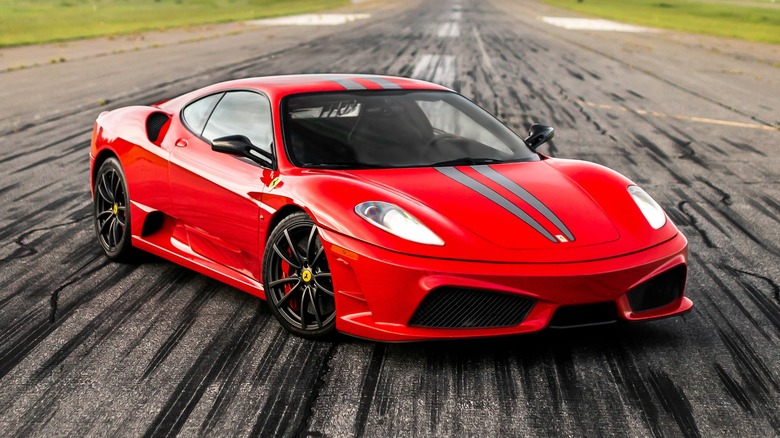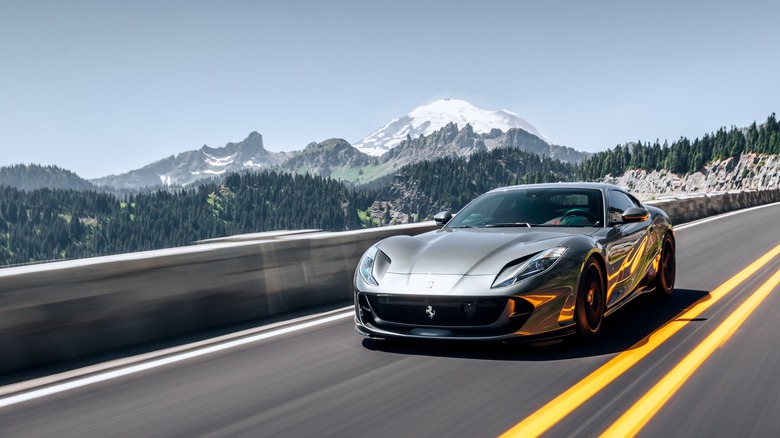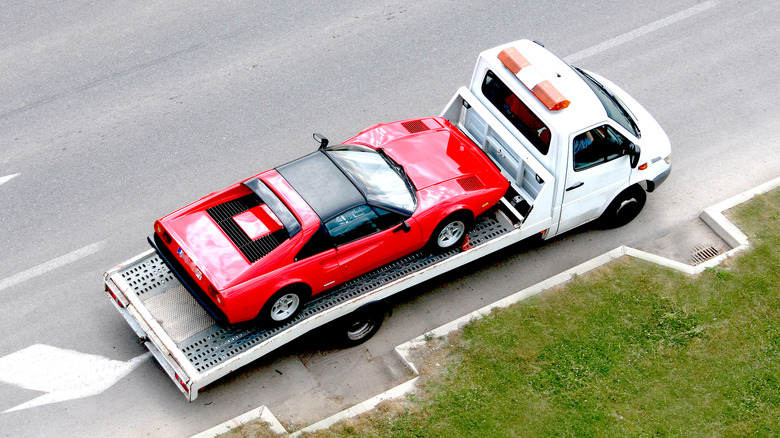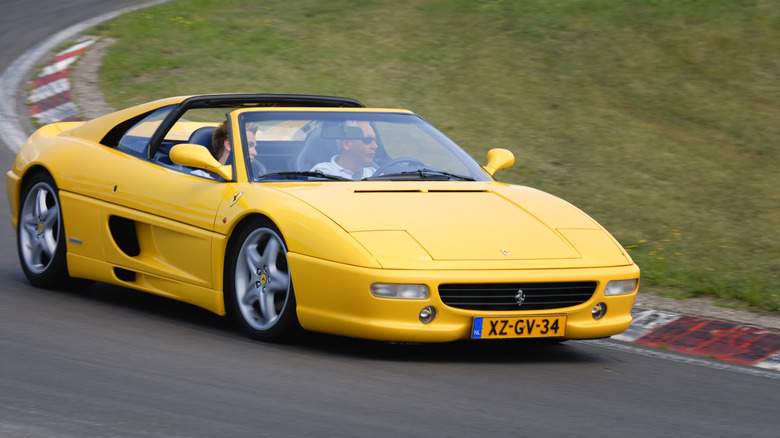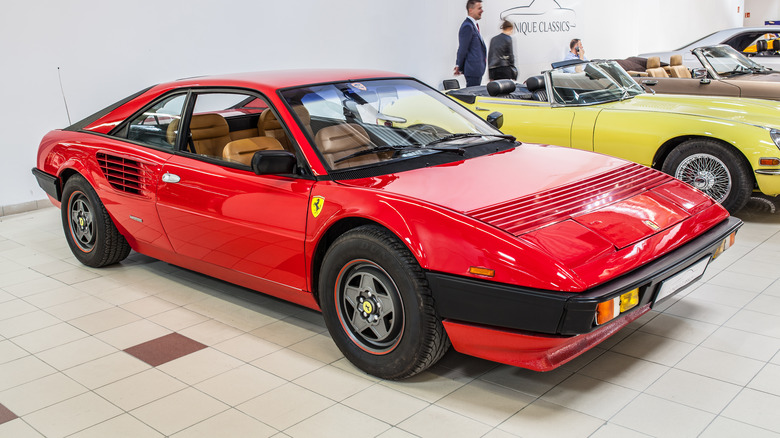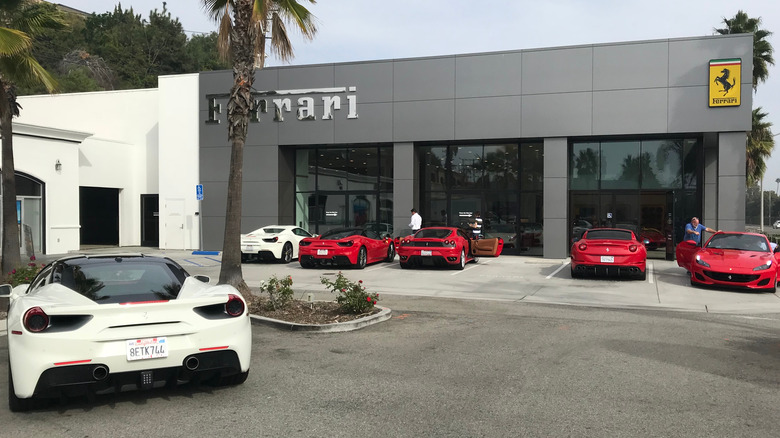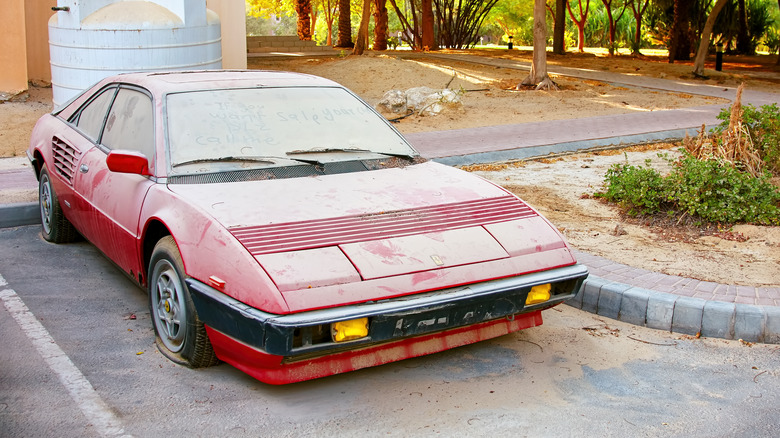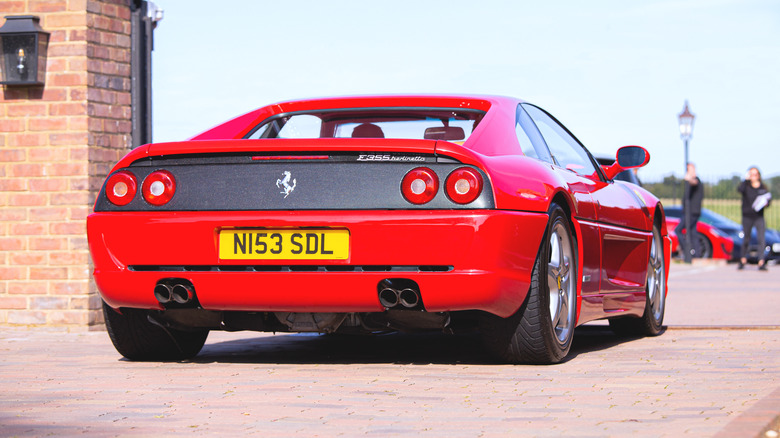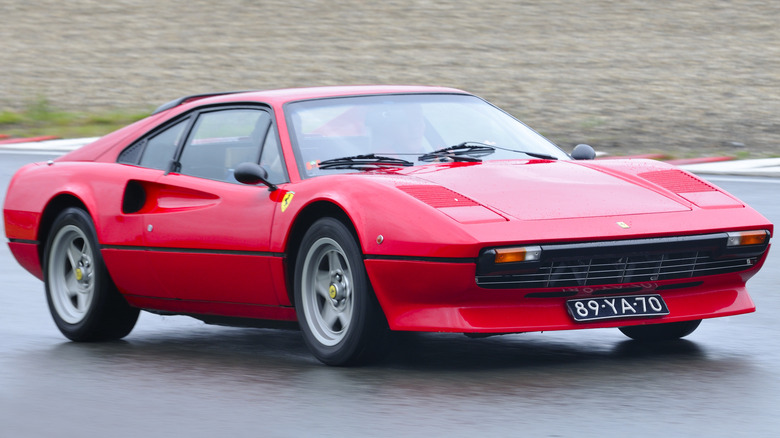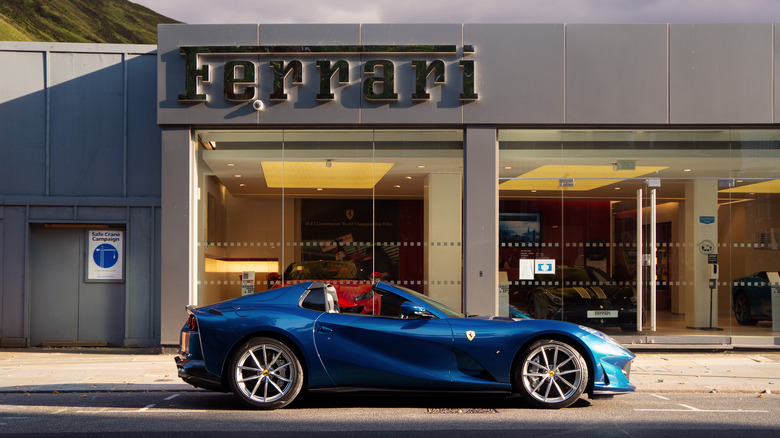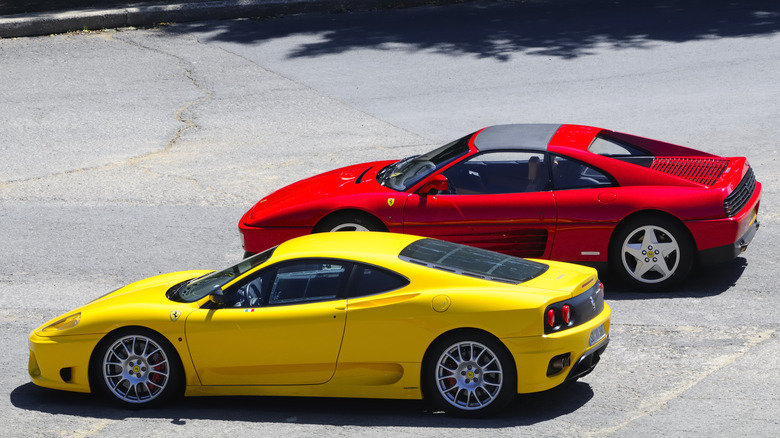10 Things About Ferraris You Should Know Before Buying One
For many enthusiasts, buying a Ferrari represents the pinnacle of performance car ownership. Ever since Enzo's first car, the 125 S, left the factory in 1947, the Italian outfit he created has remained a dominant force in motorsport, and it's produced some of the world's greatest road cars along the way. Buying a Ferrari is a way of being part of that legacy, with owners gaining access to exclusive events and meets through both official channels and local chapters of owners' clubs.
Such exclusivity, of course, does not come cheap. Even the most affordable Ferraris usually sport price tags that are out of reach to all but the wealthiest of sports car buyers, but it's also that unattainability that's a key part of the appeal for anyone with deep enough pockets to get their hands on one. If you're in the market for your first Ferrari, there's a good chance you'll be looking for an entry-level example, most likely one that's a few years old. There are plenty of pitfalls to watch out for when buying a car like this, and if you're unlucky enough to get caught by any of them, they might even be enough to ruin your ownership experience altogether. So, it's best to keep these 10 things in mind before heading to your nearest dealership or specialist.
You need to decide how you'll use it
If you're a first-timer in the market for a Ferrari, chances are you'll be fairly new to supercar ownership in general. If that's the case, then it's especially important to work out exactly what you want to use your Ferrari for before you decide on which model to buy. Ferrari's lineup includes everything from stripped-out track day toys to luxurious long-distance cruisers, with wildly different driving dynamics at each end of the spectrum.
Buy a front-engined V12 grand tourer, for example, and international road trips through winding mountain passes will fly by with ease, but take your car to a track and you might be disappointed. Likewise, a bare-bones, mid-engined V8 Ferrari will handle much better on the track, but might not be the most comfortable (or practical) thing to take cross-country. Exactly which model you go for will depend on your budget and personal tastes, but it's worth taking time to consider when and where you're actually planning on using your Ferrari so you can buy a model that matches up with those plans.
They're not reliable
While no one should be buying a supercar expecting it to be as reliable as a regular passenger car, Ferraris aren't even reliable by supercar standards. In a recent study by U.K. comparison site Uswitch, Ferraris took up three of the 10 slots on the list of the least reliable sports cars and supercars, with the 612 Scaglietti faring the worst of the bunch. Newer cars do have a much better reputation and build quality has increased overall — plus, if you're buying from a franchised dealer, you'll get a warranty no matter whether your car is new or used. Even so, it's worth keeping plenty of cash spare in the event that something does go wrong.
The questionable reliability of many Ferraris also means that they're not a great option if you're looking for a car you can drive day-to-day. While some German supercars can be feasibly used as their owner's sole vehicle, most Ferrari owners are going to have at least one other car as a backup in case of emergencies. That backup vehicle will almost certainly not have a Prancing Horse badge. In other words, while they're amazing for an occasional trip or track day use, if you can't afford at least one other car for the daily commute, you probably shouldn't be looking at a Ferrari at all.
Older cars can cost a fortune to maintain
There are no Ferraris that are "cheap" to maintain, but certain classic Ferraris can be downright extortionate to keep running if you get unlucky. For example, an F355 is one of the cheapest Ferraris to buy, but every few years, it'll need to have its engine taken out for a major service. That work alone will cost thousands of dollars, although exactly how much will vary considerably based on where you get the work done. One owner reported a bill of $28,000 for an engine-out service: $12,000 in labor, and $16,000 in parts.
A dealer will be the most expensive option, while a non-franchised specialist will be cheaper. The most wallet-friendly option is to try and do all the work yourself, but that's not advisable unless you're already an expert wrencher. Plus, skimping on maintenance to save a few bucks will likely come back to haunt you come resale time, when prospective buyers will be willing to pay significantly less if there's evidence that someone unqualified (i.e. you) has worked on the car. Really, the best way to look after a classic Ferrari is to take it to a specialist and fix any potential problems areas immediately, but to do so, you'll need to keep a rainy day fund that should be a lot bigger than many buyers of cheap Ferraris initially imagine.
Not all classic Ferraris are equal
Ferrari might have one of the world's most enviable automotive back catalogs, but that doesn't mean that every classic Ferrari is equally good. Cars like the Mondial and 400 are among the cheapest to buy, but they're cheap for a reason. In this case, it's because those two models are largely regarded as flops, both ranking by popular opinion as among the "worst Ferraris" date. Neither car sports particularly exciting driving dynamics, and in the Mondial 8's case, it can be beaten off the line by a modern Toyota Camry.
That's not to say that either of those cars isn't worth buying — more that it's worth being aware of their reputation and capabilities, or lack of them. If you're the kind of person that might be a bit self-conscious about getting overtaken by a bog-standard Toyota, it's probably best to stay away from Ferrari's more underpowered classics. There are plenty of faster Prancing Horses out there, and you won't necessarily have to pay much more for them.
Dealers won't just sell you any model
Buying a car from a dealer is arguably the safest way of ensuring you don't get caught out when buying your first Ferrari. Dealers have a strong reputation to uphold, so they're only going to sell top-quality stock — you might have to pay a premium for it, but you can be sure you're getting a good example of the car. However, going to a dealer will limit the range of cars you'll be able to buy to a degree.
First-timers at a dealership don't usually get the choice of the showroom the first time they purchase a car — some have even gone on record saying they'll try to persuade you into an entry-level used model if you're not an existing client. Franchised dealers place a big emphasis on getting customers to enter the Ferrari ecosystem and climb up the chain, and as a result, they're not going to be keen on letting a newcomer skip the queue. That's not to say new Ferraris are totally out of the question, though. If a model is less popular or coming to the end of its life span, a dealer is much more likely to let a newbie place an order. However, for the highest-demand cars or cars early in their lifespan, new buyers will have to prove their loyalty by buying a few less-coveted Ferraris first.
Be wary of cheap examples
When you're scouring the classifieds for a used bargain, it can be easy to fall into the trap of assuming a cheaper car will therefore mean less money spent overall. That's rarely the case in the world of performance cars, but with Ferrari those risks are compounded because even small problems can be very expensive to fix if left unchecked. As a rule of thumb, buying the best example you can afford — that is, a lower-mileage example with as much service history as possible — will actually work out cheaper in the long run.
If you choose to buy from a private seller in an effort to save on dealership premiums, then it's worth bringing along someone who's already familiar with Ferraris when you go and see the car if possible. Conduct a thorough inspection of the car and when you test drive it, keep an eye out for anything unusual. If anything seems off, no matter how minor, it's simply best to walk away. There are plenty of other used Ferraris on the market, and buying one cheap with a few "minor" issues could mean a lot of wallet-busting repair bills later down the line.
Watch out for model-specific quirks
Like any used car, every Ferrari model will have its weaknesses, so it's a good idea to research the common problems that the model you'll be buying suffers from before going to look at it. Buying from a dealership should negate this issue entirely, as they'll be able to talk you through all the weak spots and their stock will have had any niggling issues rectified. Buying from independent garages or private sellers requires more caution, however.
Nearly all the common failure points on any specific Ferrari model can be found by doing a few minutes' research through buying guides or owner forums, but it could save you thousands in repairs. For models like the F355 which suffered from several design flaws in their early years including soft valve guides and frequently cracking exhaust manifolds, it's also worth checking whether any previous owners have installed aftermarket parts in an attempt to correct the issues. If not, check when these parts were last replaced, and if it wasn't recently, then be prepared to factor in these additional costs yourself.
American-market cars can be less desirable
Tighter safety and emissions restrictions on Ferraris originally sold in the U.S. can mean that they're slightly slower and heavier than their Euro-spec counterparts, with the differences varying between model and year. Ferraris from the '80s like the 308 are known to be particularly different, and Euro-spec cars can often carry a premium because of this. If you're not sure whether the car you're looking at was originally American or Euro-spec, the temperature gauges can be a giveaway — if they're in Celsius, you're probably looking at a European car, whereas if they're in Fahrenheit, it's probably a U.S. domestic market car.
These differences aren't just limited to '80s classics either, as owners on Ferrari forums have reported that even more recent Euro-spec cars like the 360 Modena are noticeably faster and can sound different to their American counterparts. If you're looking for the quickest variant of your chosen Ferrari, then, it might be worth scouring the classifieds for a Euro car even if it means paying a little extra.
Financing the car is sometimes preferable
Even if you're able to pay for your new Ferrari in cash, it sometimes works out better to use financing. Ferrari has its own in-house financial services provider which lets customers lease a car for a fixed time with an optional balloon payment at the end. This means if you're looking to get your hands on the latest and greatest Ferrari models, you can do so without paying full retail price, and you can often sell cars back to dealers after a year or two of ownership.
Frequently upgrading your Ferrari is also a way to get to the front of the queue for exclusive models faster, and allows you to build rapport with both your dealer and the factory. If you're buying from an independent specialist, they'll also usually have their own finance deal available, or you can arrange one yourself. Financing can help you lease a car that would have been out of your budget otherwise, but it's most beneficial if you're shopping at franchised dealerships, as it'll give you all the reputation benefits without having to cough up the cash upfront.
They're not necessarily a good investment
Take a look at the average values of many used Ferraris over the past decade or so and it's easy to see why some buyers are now starting to look at them as rolling investments as much as automobiles. They might look like a great way to buy a desirable car and make money at the same time, but as many conventional financial institutions are keen to remind investors, past performance is not necessarily indicative of future results.
Although prices for some previously underappreciated classic models have risen dramatically over the past few years, there's no guarantee that they'll continue to rise at the same rate. In fact, some models have started to trend downwards in value again, while some have plateaued. Even if the value of your car does rise over the time that you own it, it's likely that you'll still be in the red once maintenance and running costs are taken into account. In short, buying a Ferrari as an investment is not a particularly wise idea — these are cars built to be driven and enjoyed, not treated as financial instruments. After all, that's the way that Enzo originally intended.
